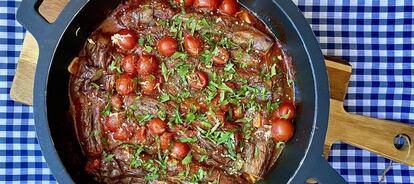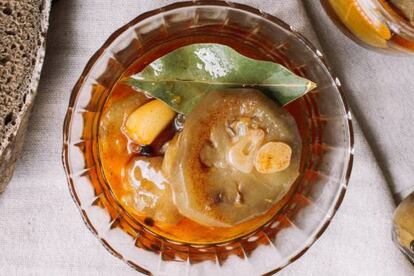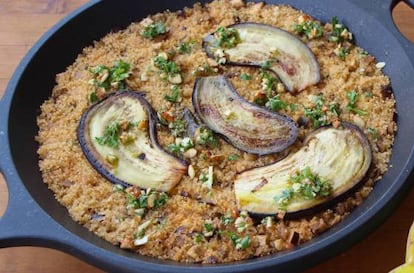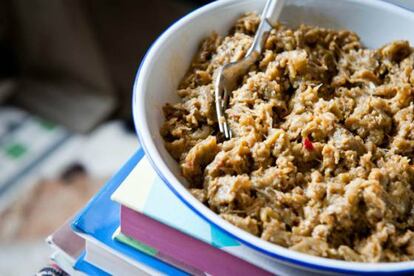Queen of summer: Cooking with eggplants
The season of the savory purple vegetable is approaching – read on for tips on the best varieties and the most delicious dishes

At EL PAÍS we like them in every way, shape and form: spreadable in sandwiches, chunky in omelets, or velvety in stews. Here follows our ode to eggplant.

Types of eggplants and how to recognize good eggplants
Eggplants are usually classified by their shapes and colors: the most cultivated include the Paula, Diva or Cava varieties, which are dark purple in color and neither too flat nor too elongated in shape. The round ones like Bonica (Catalan variety), Rondona or Black Beauty have a flattened shape and are quite productive varieties, with fruits weighing 300-400 grams and some weighing up to a kilo.
Then there are the striped varieties such as Leire, Angela or Sicilian, easy to recognize by their striking combination of colors ranging from white to purple, increasingly easy to find in greengrocers as they can be grown over an extended season. Within the elongated eggplants are the varieties Mirabelle, Helena, Mileda or Violet – originating from Asia, thin and with sweet flesh –, while a variety called “meter” can exceed 40 cm per fruit.
Good specimens should have a smooth skin and tight flesh, be heavy in proportion to their size and not yield easily when squeezed (this may mean that they have many seeds). The stem, or peduncle, is also a good indicator of freshness: if it is dark green and looks fresh, it is a good sign; if it tends to be gray and looks limp, pick another one. Be careful because these stems can have small prickly thorns (if you thought that “Stinging Peduncle” could be a drag name, that makes two of us), although most of the varieties grown today have been domesticated and do not have these thorns. You can keep them in the fridge – in the least cold part –, and never in plastic bags: if you want to extend their shelf life, pickle them, sterilize them in jars and you will be able to enjoy them for a long time.

Preparation: salt your eggplants
The flesh of eggplants has an intrinsic bitterness that is pleasant when they are at their best, but can become too harsh, for example if they have a lot of seeds or if they have been harvested a long time ago and have become soft. Not all eggplants have to go through this process, but if you want to do it you can add a little salt on top and let them stand for half an hour, then drain the bitter water they have released (you can put them directly on a strainer to make it easier). Normally they are usually cut in slices before putting the salt on top, but you can also cut them in two lengthwise and leave them on a sieve face down: you will notice the difference. I have read that soaking them in cold water also works, though I have never tried it.
Fried and battered
One of the characteristics of eggplant flesh is its sponginess – a texture which is good for many things, though it will absorb a lot of oil if you don’t use the right technique.
Try eating your fried eggplant simply with honey or with quince mayonnaise; seasoned with citrus and your favorite spices. You can also stuff them, Cretan-style, with vegetables and feta (although prepare plenty of oil, which you will need).
For battered eggplant, slice the fruit thickly, dipping the slices in beer and then dredging them in wheat or chickpea flour before frying them.
You could bread them with egg and breadcrumbs, but I do not think this is the best way: the bread burns easily before the eggplant is cooked, and if you lower the temperature to prevent burning, the vegetable gets soaked in oil.
Roasted
At 180ºC, or a little more if the oven is very full, we can cook eggplants, peppers, carrots, potatoes, tomatoes, onions and more, as long as we remember to take each thing out at the right time. You can also roast eggplants on the barbecue, and if they get burned or the fire goes out too soon, pop them in the microwave for three or four minutes to soften the texture.
To make babaganoush:
Wash the eggplants and have metal tongs handy. Over medium heat, place the eggplants on the burners, resting on the grills. Turn them every five minutes so that they cook through; they are ready when they are soft all over and have blackened skin. Add a drizzle of oil, a creamy cheese, salt, pepper and lemon zest or some fresh herbs

Another advantage of roasted eggplants is that you can prepare more elaborate dishes with them: dressed with yogurt and romesco, stuffed with a textured soybean stew, gratinated with cheese or bathed in garam masala curry. Roasted eggplants are also a must for escalivada, the Catalan salad made with onions and peppers.
Air-fried
If you have an air fryer, you can do many of the things we have mentioned in the previous sections. You can roast eggplants, placing them in the air fryer and turning them over from time to time; you can spray with oil and fry them, or even make a kind of “dry” ratatouille. Remember, it is important to stir frequently, so the food is in contact with the hot air.
Stewed
Stew eggplants to cut down cooking time, cutting them into small pieces, so they become tender more quickly, added to sauces, wine, broth, water, or other vegetables that release their juices.
With quinoa

Cut four eggplants lengthwise and put them flesh side down in a frying pan or casserole over medium heat, with a drizzle of oil. Leave them for three or four minutes and then pour a small can of chopped tomatoes on top. Add a little more oil, salt, spices or herbs to taste (I use za’atar), cover, but not completely, leaving the lid off a small part, and cook over medium heat for about 12 minutes.
After that time, uncover more so that the water evaporates and the sauce concentrates, between five and 10 minutes more. Once off the heat, add a clove of garlic, finely chopped and well distributed so that it cooks with the residual heat, a little more of the spices and some fresh herbs (I used parsley). They can be served on toast, with brown rice or couscous or eaten cold, as a salad.
Grilled
Grilled eggplant is simple and relatively quick but has one risk: they dry out, and can end up looking like jerky. To avoid that, use the juiciest and freshest eggplants, cut them somewhat less than a centimeter, and cook over medium heat in a griddle or frying pan with very little or no oil. You can also marinate the eggplants with spices such as curry powder, paprika, and garlic before grilling to add flavor.
Boiled
It may sound strange, but boiling eggplant is a very valid cooking method for certain types of recipes; either steamed in the microwave for about 15 minutes or boiling in water, previously cut in thick cubes and draining well afterwards. With them you can prepare pasta sauces and tasty Moroccan zaluk. After having tried it this way, I dare say boiling eggplant would also work in dishes that call for roasted eggplant, because it is still mellow and has a much more pleasant texture than it may seem.

Tu suscripción se está usando en otro dispositivo
¿Quieres añadir otro usuario a tu suscripción?
Si continúas leyendo en este dispositivo, no se podrá leer en el otro.
FlechaTu suscripción se está usando en otro dispositivo y solo puedes acceder a EL PAÍS desde un dispositivo a la vez.
Si quieres compartir tu cuenta, cambia tu suscripción a la modalidad Premium, así podrás añadir otro usuario. Cada uno accederá con su propia cuenta de email, lo que os permitirá personalizar vuestra experiencia en EL PAÍS.
¿Tienes una suscripción de empresa? Accede aquí para contratar más cuentas.
En el caso de no saber quién está usando tu cuenta, te recomendamos cambiar tu contraseña aquí.
Si decides continuar compartiendo tu cuenta, este mensaje se mostrará en tu dispositivo y en el de la otra persona que está usando tu cuenta de forma indefinida, afectando a tu experiencia de lectura. Puedes consultar aquí los términos y condiciones de la suscripción digital.
More information
Últimas noticias
From Andorra to Gibraltar, a black market for Ozempic exploits its success: ‘They’re the most sought-after products in the world’
Magnets in their heads: How some animals guide themselves using the Earth’s magnetic field
From Hungary’s Orbán to Chile’s Kast: How Trump helps turbo charge the far right
The brief rise and retreat of Generation Z in Mexico
Most viewed
- Why we lost the habit of sleeping in two segments and how that changed our sense of time
- Charles Dubouloz, mountaineering star, retires at 36 with a farewell tour inspired by Walter Bonatti
- Venezuela faces its most tense Christmas yet
- CBS in crisis after pulling a report on Trump’s deportations to El Salvador (which later leaked online)
- Bukele clan fumes over investigation exposing their new wealth











































